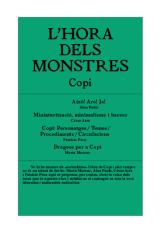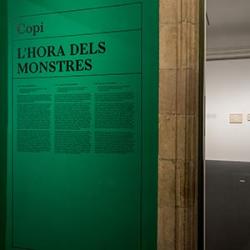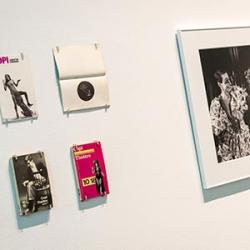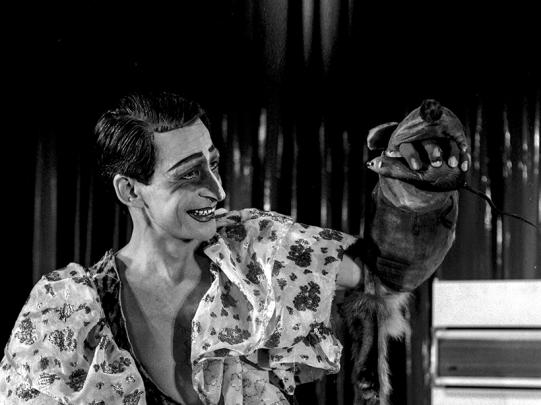The Time of Monsters
Copi
05.11.2016 – 16.02.2017
RELATED ACTIVITIES
Through book presentations, talks, round tables, plays and master classes, La Virreina Centre de la Imatge offers an introduction to the figure of Copi by specialists (but not for specialists) in his work. Marilú Marini, Alan Pauls, Daniel Link, Marcos Ordóñez, Biel Mesquida, Patricio Pron and others will take a fresh look at the more mainstream ideas surrounding his work, discuss its relevance today and its legacy, and contribute with their voices to a choral narrative on Copi, one of the most iconoclastic and groundbreaking artists of the 20th century.
LECTURE
This! Now! Right now!
Tuesday 10 January at 7 pm. Virreina LAB
“The three radical hypertrophies that render Copi uncompromisingly unique are hypervisibilisation (everything is seen), hyperverbalisation (everything is said) and hyperpresentification (everything happens here and now)”, states Alan Pauls. On the basis of these hypertrophies (which constitute “the monstrous” in his work), the author of The Past will reconstruct Copi’s stage production and discuss with Patricio Pron the way in which Copi conceived his theatre as an ecstatic and accelerated image of turbulent times.
Lecture given by Alan Pauls, Writer, literary critic and argentinian scriptwriter.
Free entry. Limited places
LECTURE
Copi: Characters / Topics / Procedures / Circulations / Monsters
Wednesday 11 January at 7 pm. Virreina LAB
Who was Copi? Was he a “bad” cartoonist? Why is his work teeming with transvestites? What is camp? Why do his characters keep coming back, and why do they all come to a bad end? What does “coming to a bad end” mean in Copi’s work? Patricio Pron, curator of the exhibition “Copi, the Time of Monsters”, will discuss the topics, the characters and the procedures used in the work of the author of El uruguayo. (The talk will include jokes; unfortunately, almost all of them bad.)
Lecture given by Patricio Pron, the curator of the exhibition.
Free entry. Limited places
ROUND TABLE
We loved Copi so much: Jorge Herralde, Marcos Ordóñez and Biel Mesquida on Copi in Barcelona
Thursday 19 January at 7 pm. Virreina LAB
One of the most evident continuities in Copi’s unorthodox life was his amorous relationship with Barcelona, a city he visited frequently, fascinated by the free, easygoing atmosphere that reigned in its streets in the late 1970s: it was here that he found his publisher in Spanish, Jorge Herralde, he performed at the Diana Theatre (in a performance witnessed by writer and drama critic Marcos Ordóñez), he met Ocaña and Nazario, and he had lovers and friends like the Majorcan writer Biel Mesquida. All three will rekindle their memories of Copi, evoking the Barcelona of those times but also vindicating its relevance today and that of the creator of the seated woman.
Free entry. Limited places
BOOK PRESENTATION
Copi, The Time of Monsters
Friday 20 January at 7.30 pm. Laie Bookshop (Pau Claris, 85)
Patricio Pron, curator of “Copi, the Time of Monsters”, and Valentín Roma, director of La Virreina Centre de la Imatge, will present at Laie Bookshop the book published to coincide with the exhibition. The book features texts by Alan Pauls, César Aira, María Moreno and Patricio Pron.
Free entry. Limited places
LECTURE
Copi, revolt and trans anthropology
Wednesday 25 January, at 7 pm. Virreina LAB
Raised on the contestation inherent in his time (Teatro Pánico and Grupo Tse, and May 68, which was a leitmotif of his narrative work), Copi came to put forward a radical worldview which, at the same time as it subverted the brutal logic of the most advanced capitalism, proposed new rituals (in the theatre, in the novel, in graphic work) to found a trans universe: one that was transgender, translinguistic. Copi’s logic is simple: to oppose the nation-state and its warlike fictions (the avant-garde being one of them) with the idea of the community (transnational and at the same time impossible). For this reason Copi abandons the world and proposes a cosmopolitics in which he smashes all inherited ideas and founds a new anthropology that subsumes warmth (the lamb’s blood) into cold (the snake’s body, the drug addict’s frozen body); that makes the monsters of the underworld (the snake, the rat, the dead child) appear in the ascensional; that traces, in the facade of capitalism, the lines of its collapse; that transforms the eye of God (and his lamblike embodiment) into the snake’s arsehole.
Lecture given by Daniel Link, Professor and writer.
Free entry. Limited places








